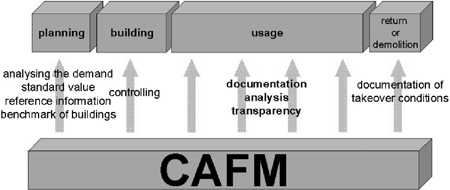Introduction
Within This Page
What is CAFM?
CAFM software provides the facility manager with the administrative tools and the ability to track, manage, report, and plan facilities operations. This function is associated more as an administrative function and not a technical activity. For example, CAFM systems can contain data that identifies departments and staff, identifies and tracks who has space access rights and security level, as well as leased space information including leasing, income, and tenant charge-back information.
Not to confuse a Computerized Maintenance Management System (CMMS) with a CAFM system, consider a patient room in a hospital. Ensuring that the Nurse Call System in the room is "properly inspected, maintained, and repaired" is a CMMS activity. "Knowledge" about the medical department staff, and the specific patient(s) in the room, the room's contents (phones, TVs, beds–including their movement from room-to-room), and equipment connections (electrical, oxygen, communications, etc.) relate to CAFM activities. CMMS and CAFM systems have begun to continue to merge into Integrated Work Order Management Systems (IWOMS).
Computer-Aided Facilities Management (CAFM) includes the creation and utilization of Information Technology (IT)-based systems in the built environment. A typical CAFM system is defined as a combination of Computer-Aided Design (CAD) and/or relational database software with specific abilities for Facilities Management (FM).
The purpose of a CAFM system includes:
- Helping the facility manager ensure the organization's assets are fully utilized at the lowest possible cost, while providing benefit to every phase of a building's lifecycle, and
- Supporting operational and strategic facility management, i.e. all of the activities associated with administrative, technical, and infrastructural FM tasks when the facility or building is operational, as well as the strategic processes for facilities planning and management¹.

CAFM systems consist of a variety of technologies and information sources that may include object-oriented database systems, CAD systems, Building Information Models (BIM), and interfaces to other systems such as a Computerized Maintenance Management System (CMMS). Today most CAFM systems are web-based and provide a host of features including facilities related scheduling and analysis capabilities. Data may be collected from a variety of sources through technology interfaces or human transfer processes. Data may be stored, retrieved, and analyzed from a single data-store.
Description
CAFM evolved in the late 1980's leveraging the personal computer (PC) to automate the collection and maintenance of FM information. Widespread usage of Information Technology (IT) systems in almost all disciplines eventually penetrated the construction and FM industry as well. After the development of Internet-based database systems, usage of high-end tools in FM practices increased in that sector. CAFM systems provided the facility manager with the tools to track, plan, manage, and report on facilities information.
CAFM systems combine and analyze complex data to improve FM practices throughout a variety of industries including government, healthcare, educational, commercial, and industrial environments. The CAFM system gives decision makers the ability to automate many of the data-intensive facility management functions and typically results in continuous cost savings and improved utilization of assets through-out their entire lifecycle.
Although there is no ideal model suitable for all situations, to meet the specific demands of the facility manager, a well developed CAFM system will often include a variety of functions and features. CAFM systems typically provide and maintain information on floor plans, property descriptions, space utilization, energy consumption, equipment locations, and other critical infrastructure data that pertains to the sector it is serving.
Features of Integrated CAFM Systems and Capabilities
Integrated CAFM systems are equipped with intelligent interfaces, advanced automated FM functionalities, and links between various external analysis packages. The following features are common to most CAFM systems:
Interactive Database: Since the data is crucial in FM practice, CAFM systems are based on fully developed relational databases that are designed around the functional requirements of the Facility or Space Manager.
Interactive Graphics: CAFM systems facilitate an interactive graphics module for basic drafting and modification of facility layouts, plans and other visual documents. A majority of CAFM systems on the market integrate industry standard CAD engines into the CAFM system to utilize common CAD file formats. Implementation of building information modeling (BIM) into the CAFM environment is beginning to provide far more robust information from the point of commissioning onward. Using open standards based BIM and tools such as Construction Operations Building information exchange (COBie) allows for interoperability of various mobile tools so that the user can have the information available when needed often saving multiple trips and significant research time. Additionally, the graphics data may be maintained in a format compatible with Geographic Information System (GIS) standards that will allow CAFM information to be accurately shared across multiple platforms, including spatial environments.
Data Management Tools: CAFM systems reuse existing data and are able to recognize and/or convert external data into useful information. These tools usually provide a robust user interface to enable a user-friendly environment for data input, editing, and analysis.
Challenges and Obstacles
Facility managers typically face a variety of constraints and challenges. Those most often encountered today include the following:
- Shrinking maintenance budgets
- Resource constraints
- Political priorities
- Unfunded mandates
- Distributed data and data disparities
- Organizational stovepipes
The challenge for facility managers is to overcome these obstacles by utilizing the resources available and convincing leadership that efficiencies and cost savings can be achieved with investments in technology, such as a well planned CAFM system. Mature CAFM systems are important to enable facility managers to become effective decision makers and provide effective management of facility information.
Benefits
CAFM system benefits include the following:
Strategic Planning: Tasks include analyses of property and space to provide capital planning of new or remodel assets to improve the mission of the organization. CAFM will aid in determining space requirements, equipment locations, construction costs, environmental constraints, encroachments, and other critical planning functions.
Space Inventory and Management: CAFM can define and standardize space attributes and data elements as well as the physical asset inventories of the organization including analysis of space dimensions and utilization, hazardous material locations, evacuation routes, fire equipment locations, and buildings attributes such as:
- Age
- Cost data
- Life expectancy
- Construction data
- Contract and Warranty data
- Building managers
- Telephone numbers
- Technology drops
Operations: Tasks include tracking energy consumption, utilities monitoring, lighting management, janitorial, and grounds maintenance responsibilities and costs.
Maintenance and Repairs: Tasks include monitoring routine repairs and preventive maintenance operations. Safety conditions, such as a lock-out/tag-out program can also be managed.
Assessments: This function typically includes building condition inspections, condition reporting, security vulnerability, and risk assessments. Often these have an interface for a GIS to achieve the benefits of a spatial reporting environment as well as CAFM.
Space Forecasting: Includes the ability to determine current space utilization and to project future space requirements based on customer or mission requirements. This task typically includes the ability to manage the requirements for people, space, utilities, technology access, as well as the cost and move planning features.

Fig. 1. Usage of CAFM in the life cycle of a building
Credit: Schürle and Fritsch, 2000²
Benefits of CAFM usage in FM tasks can be organized into quality of life, cost reduction, cost avoidance, and information improvement. Typical benefits include the following:
- More efficient space utilization to achieve cost savings and potential reduction in asset inventories.
- Reduced moving and relocation activities resulting in greatly reduced relocation costs.
- Continuous improvement in FM efficiencies.
- Improved project planning leading to reductions in architectural and engineering, construction, and building maintenance costs.
- Fast and accurate reporting on critical facilities information.
- Existing processes will become more efficient and streamlined, using standardized data that is shared across the enterprise.
- CAFM will give facilities managers the tools necessary to become more proactive instead of reactive to facilities' requirements and enable better decision making.
- Improve safety and environmental planning capabilities, reducing risk from accident and regulatory compliance violations.
- Disaster planning capabilities are significantly improved to reduce the potential for human injury or death in a disaster as well as to improve those planning capabilities required for operational recovery.
- Data standardization across the organization and the elimination of redundant information held by multiple organizations in various degrees of quality and accuracy.
Relevant Codes and Standards
Relevant standards for CAFM systems are based on CAD, BIM, and Database file formats.
- buildingSMART alliance
- CAD-GIS-BIM Open Standard—OWS-4
- COBie
- Spatial Data Standards for Facilities, Infrastructure, and Environment (SDSFIE)
- U.S. National CAD Standard®
- World Wide Web Consortium (W3C) Fourth Edition and XML 1.1
Major Resources
Publications
- Facility Management, 2nd Edition, Edmond P. Rondeau, Robert Kevin Brown, Paul D. Lapides, ISBN: 0-471-70059-3, Wiley, January 2006.
- ¹ Abel, J., Lennerts, K. 2005. "Where does CAFM really help? Current fields of application and future trends according to system users" . In: Proceedings of CIB W78's 22nd International Conference on Information Technology in Construction, CIB Publication 304, ISBN 3-86005-478-3, The Westin Bellevue, Dresden, Germany, 19-21 June 2005.
- ² Schürle, T., Boy, A., Fritsch, D. (2000): IAPRS, Vol. 33, Working Group IV/III.1 – CAFM Data Structures: A Review And Examples , Published by German Institute for Photogrammetry (ifp), Stuttgart University, Germany.
Organizations
- BOMA International
- buildingSMART Alliance
- Facility Maintenance and Operations Committee
- FIATECH
- International Facility Management Association (IFMA)
- National Institute of Building Sciences








